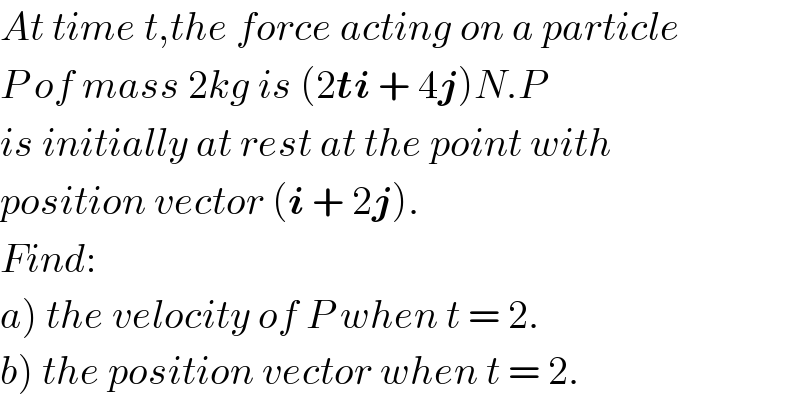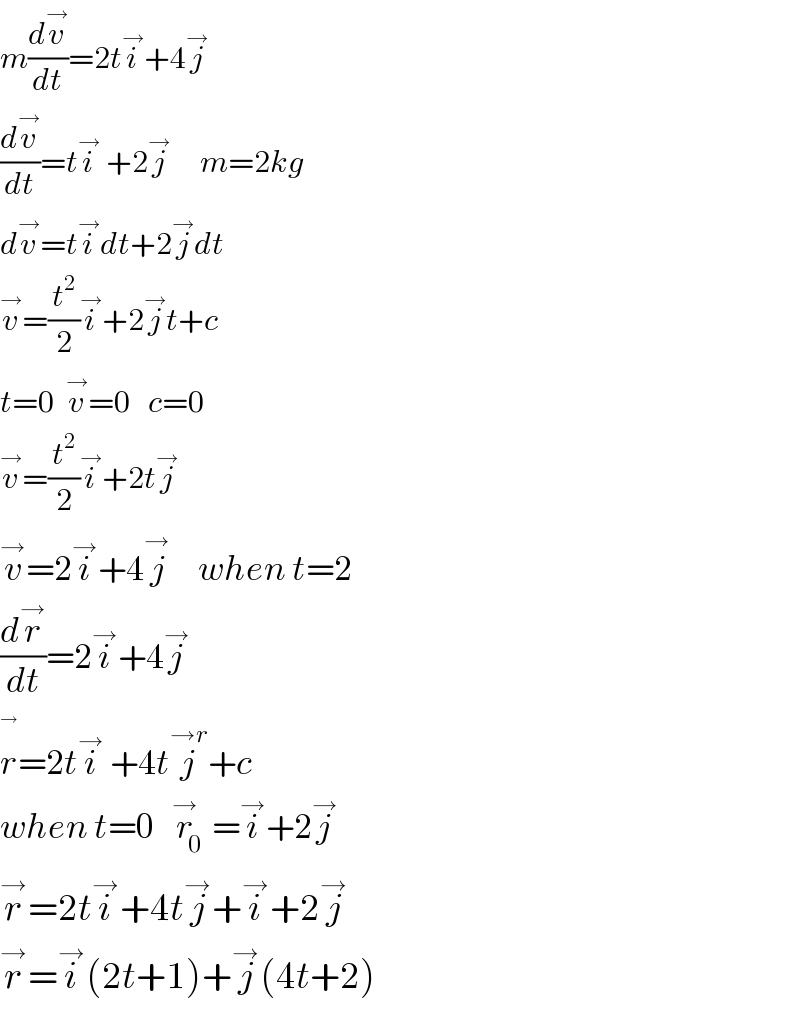Question Number 38366 by Rio Mike last updated on 24/Jun/18

$${At}\:{time}\:{t},{the}\:{force}\:{acting}\:{on}\:{a}\:{particle} \\ $$$${P}\:{of}\:{mass}\:\mathrm{2}{kg}\:{is}\:\left(\mathrm{2}\boldsymbol{{ti}}\:+\:\mathrm{4}\boldsymbol{{j}}\right){N}.{P} \\ $$$${is}\:{initially}\:{at}\:{rest}\:{at}\:{the}\:{point}\:{with} \\ $$$${position}\:{vector}\:\left(\boldsymbol{{i}}\:+\:\mathrm{2}\boldsymbol{{j}}\right). \\ $$$${Find}: \\ $$$$\left.{a}\right)\:{the}\:{velocity}\:{of}\:{P}\:{when}\:{t}\:=\:\mathrm{2}. \\ $$$$\left.{b}\right)\:{the}\:{position}\:{vector}\:{when}\:{t}\:=\:\mathrm{2}. \\ $$
Answered by tanmay.chaudhury50@gmail.com last updated on 25/Jun/18

$${m}\frac{{d}\overset{\rightarrow} {{v}}}{{dt}}=\mathrm{2}{t}\overset{\rightarrow} {{i}}+\mathrm{4}\overset{\rightarrow} {{j}} \\ $$$$\frac{{d}\overset{\rightarrow} {{v}}}{{dt}}={t}\overset{\rightarrow} {{i}}\:+\mathrm{2}\overset{\rightarrow} {{j}}\:\:\:\:\:{m}=\mathrm{2}{kg} \\ $$$${d}\overset{\rightarrow} {{v}}={t}\overset{\rightarrow} {{i}dt}+\mathrm{2}\overset{\rightarrow} {{j}dt} \\ $$$$\overset{\rightarrow} {{v}}=\frac{{t}^{\mathrm{2}} }{\mathrm{2}}\overset{\rightarrow} {{i}}+\mathrm{2}\overset{\rightarrow} {{j}t}+{c} \\ $$$${t}=\mathrm{0}\:\:\overset{\rightarrow} {{v}}=\mathrm{0}\:\:\:{c}=\mathrm{0} \\ $$$$\overset{\rightarrow} {{v}}=\frac{{t}^{\mathrm{2}} }{\mathrm{2}}\overset{\rightarrow} {{i}}+\mathrm{2}{t}\overset{\rightarrow} {{j}} \\ $$$$\overset{\rightarrow} {{v}}=\mathrm{2}\overset{\rightarrow} {{i}}+\mathrm{4}\overset{\rightarrow\:} {{j}}\:\:\:\:{when}\:{t}=\mathrm{2} \\ $$$$\frac{{d}\overset{\rightarrow} {{r}}}{{dt}}=\mathrm{2}\overset{\rightarrow} {{i}}+\mathrm{4}\overset{\rightarrow} {{j}} \\ $$$$\overset{} {{r}}=\mathrm{2}{t}\overset{\rightarrow} {{i}}\:+\mathrm{4}{t}\overset{\rightarrow{r}} {{j}}+{c} \\ $$$${when}\:{t}=\mathrm{0}\:\:\:\overset{\rightarrow} {{r}}_{\mathrm{0}} =\overset{\rightarrow} {{i}}+\mathrm{2}\overset{\rightarrow} {{j}} \\ $$$$\overset{\rightarrow} {{r}}=\mathrm{2}{t}\overset{\rightarrow} {{i}}+\mathrm{4}{t}\overset{\rightarrow} {{j}}+\overset{\rightarrow} {{i}}+\mathrm{2}\overset{\rightarrow} {{j}} \\ $$$$\overset{\rightarrow} {{r}}=\overset{\rightarrow} {{i}}\left(\mathrm{2}{t}+\mathrm{1}\right)+\overset{\rightarrow} {{j}}\left(\mathrm{4}{t}+\mathrm{2}\right) \\ $$
